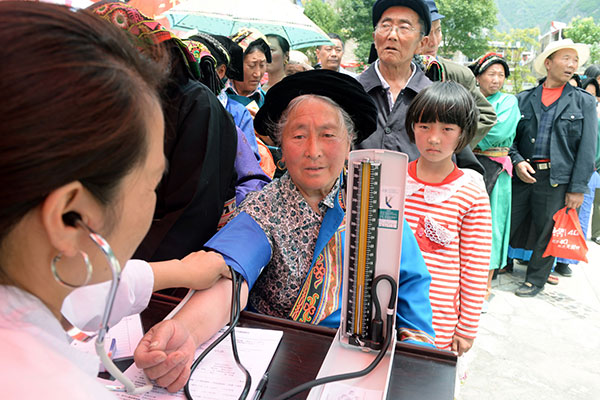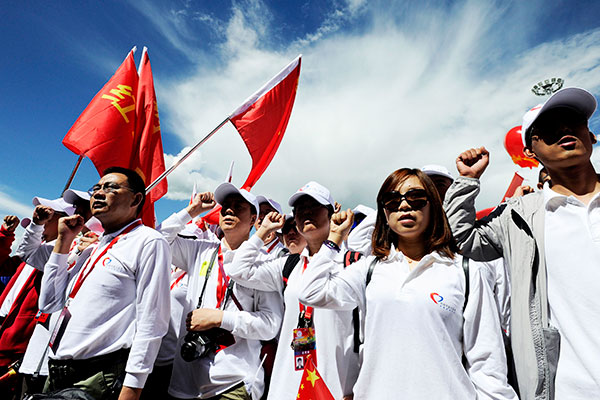
Residents of Ganbao, Lixian county, line up for free medical services offered by the “Building Chinese Hearts” project.[Photo/for China Daily]
More than 800 physicians have just spent a week providing free medical treatment to residents of one of China’s most isolated regions, and the seven-day excursion was beneficial to both parties.
“I can hear!” Emato said with tears in her eyes as she held the hands of two practitioners of traditional Chinese medicine who had just performed 10 minutes of acupuncture.
It was the first time the 22-year-old Tibetan had heard the word clearly since her hearing was severely impaired after an illness when she was 3 years old.
The condition kept Emato out of the local schools, and her daily life in Shashiduo, a small town in the Aba Tibetan and Qiang autonomous prefecture in Sichuan province, has revolved around helping on the family farm and grasslands.
“Her hearing impairment is mainly caused by pressure from the cervical vertebrae (which support the head). She still needs further checks and treatment on the vertebrae,” said Deng Tiancai, a Chinese-Malaysian doctor of traditional Chinese medicine.
Emato is one of 9,175 people benefiting from “Building Chinese Hearts”, a project sponsored by pharmaceutical companies and overseen by the Chinese government, which was set up after the 2008 Wenchuan earthquake, which killed more than 80,000 people. The project is active across the Tibetan autonomous region and in areas of provinces such as Sichuan, Yunnan, Gansu and Qinghai that are home to large populations of ethnic Tibetans.
Buddhist monks and nuns accounted for 1,799 of the 9,000-plus patients, but the overwhelming majority were poorly paid herders and farmers.

Physicians from Beijing check the blood pressure of a middle school teacher in Chali town in the Aba Tibetan and Qiang autonomous prefecture.[Photo/for China Daily]
Volunteers and vaccines
Deng was one of 800 practitioners from around China who volunteered to take part in a seven-day excursion to provide free treatment in Aba, which is home to about 900,000 nomads and farmers from different ethnic groups, including Tibetans, Qiang, Hui and Han Chinese. Tibetans account for 54 percent of the total mix.
Air China provided 10 planes to transport the physicians and medical supplies to mountainous Aba.
The medical team consisted of three academicians from the Medical Sciences Department of the Chinese Academy of Engineering, and more than 800 physicians, all of whom have been educated to professorial level. Upon arrival in Aba, the main team was divided into six units, which visited 35 towns in six counties in the prefecture.
In the other seven counties, four other medical teams screened locals for congenital heart disease, while another, from the Dongzhimen Hospital in Beijing, examined people for signs of brain paralysis. Five children underwent surgery. Meanwhile, two teams of ophthalmologists from Tongren Hospital and Anzhen Hospital in Beijing-two of China’s top centers for eye surgery-performed cataract operations, curing more than 50 people.
A couple of smaller medical squads were also sent deep into the grasslands to provide treatment to isolated herders and farmer.
After conducting physical checks on 300 children, the medics screened six of them for heart disease. Although only one case was confirmed, Zhang Zhe, a cardiologist at the Peking University No 3 Hospital, was concerned that some children may have slipped through the net: “I’m worried that many children who live with their parents in the far pastures will miss the chance to be screened. Local public hospitals should pay special attention to screening work to diagnose the disease as early as possible.”
Despite the government’s push to improve living standards in these isolated regions, local herdsmen and farmers still have endemic conditions such as Kashin-Beck disease, skin disorders and gynecopathy, diseases that only occur in women. All the complaints are associated with poor hygiene and a nomadic life-style.
The symptoms of Kashin-Beck disease, which affects the bones, include pain and stiffness in joints, and enlarged joints in the fingers. In some parts of Aba, one in seven people have the disease, and the high incidence rate is attributed to a lack of selenium and iodine in the water. High blood pressure, diabetes, and heart and lung diseases are common complaints among the monks and nuns.
Fu Wei, a general surgeon and deputy Party chief at Peking University No 3 Hospital, led 10 experts from 10 departments, including cardiology, neurology, neurosurgery, rheumatism, orthopedics, gynecology, pediatrics and ophthalmology, to Aba. “We conducted research into the diseases in Aba and then organized this team of volunteers to better serve the needs of local people,” he said.
Buchang Pharma, a drug company headquartered in Beijing, donated medicine worth 9 million yuan ($1.5 million), which was transported to the 35 towns by the township governments. All the drugs had been prescribed within one week of arrival.
The visiting medics also set up a public health school in Ma’erkang county, the home of the prefecture’s government. Hospitals in larger cities will regularly send physicians to the school, or use the Internet to train and consult with local practitioners.
In July, two academicians from the Chinese Academy of Sciences gave the school’s first training session, which focused on the treatment and prevention of heart and cerebral diseases, and gynecology.
“The purpose of setting up this health school is to make good use of modern technology and the resources in big cities to help underdeveloped areas and establish a permanent medical team for the people,” said Wang Longde, the school’s principal and an expert in epidemiology. The school is open to all the practitioners at Aba’s township clinic because they take on most of the minor cases in the area.

Medical experts pledge to provide free treatment in Hongyuan, Aba prefecture, on July 3.[Photo/provided to China Daily]
A lucky find
“I found some brand-new physiotherapy equipment in unopened, dust-covered boxes in the warehouse of the township clinic. The local doctors said they didn’t know how to use the machines, but a large number of patients with bone and skin complaints needed the therapy,” said Ding Yonghong, a physiotherapy expert from the Babaoshan Community Clinic in Beijing, who treated hundreds of patients in Chali.
Ding and her assistant Yin Yuanyuan moved the equipment to their treatment rooms, and spent half a day teaching two local doctors how to use it. A lack of familiarity with the equipment meant the locals were wary of touching it, according to a 20-something physician. “We were worried we might damage the expensive equipment the central government supplied, so we just left it alone. I really appreciate Dr Ding’s help,” she said.
Yin said she and Ding were pleased that the equipment will now be put to good use. “On the morning of the first day, Ding and I were too busy to drink even a drop of water. To ensure that all the patients in the waiting room had access to therapy, we had to shorten the treatment time. Now, two of our local colleagues have learned to use the machines, so we are relieved that the equipment will not stand idle.”
After just 15 minutes of radiotherapy, Gomyn, a 92-year-old Tibetan monk, reported a marked reduction in the pain in his leg. He gave Ding a thumbs-up even before he’d climbed off the treatment couch.
With one of the local physicians acting as a translator, the old monk said he deeply appreciated Ding’s help and was extremely surprised at the beneficial effects of the radiotherapy, a treatment he hadn’t experienced before. “I will come for therapy again in the future,” he said.
Lou Lou, a gynecologist from Shanghai, felt nauseous and faint after examining several women in Chali. Tibetan women are extremely shy, so they rarely remove their clothes to wash. They apologized repeatedly for their pungent body odors.
“I just told them to pay attention to their personal hygiene every day, and to not sit directly on damp, cold grassland,” Lou said. “If they follow my suggestions, they can avoid many of their problems.”
Speaking via an interpreter, Droma, a Tibetan in her mid-40s, said: “I know what Dr Lou said is right. But I work on the grassland during the summer and autumn season every year. Hygienic conditions are poor and we Tibetan women just sit on the grassland directly while milking yaks and doing the other work. We’ve done it for generations, and we never bring a stool with us.”
Jamuco, a 30-something Tibetan who works as an official for the Chali township government, said things are changing for the better. “The young people pay more attention to health and lifestyle issues than the older generation. It takes time for changes to come through, but I can already see some positive changes have already occurred through the evolution of the nomadic civilization and the development of Tibetan society.”
